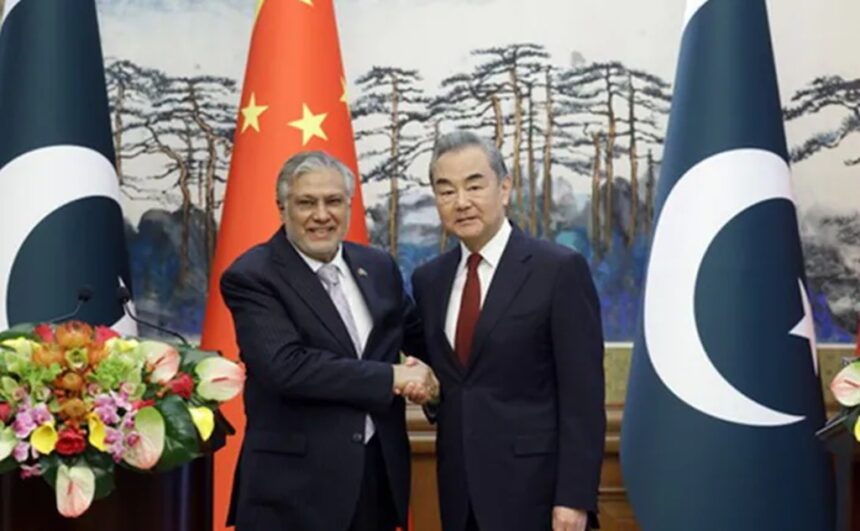BEIJING – China has restated its strong backing for Pakistan as tensions with India remain high. Chinese officials told Pakistan’s Foreign Minister Ishaq Dar that China “stands firmly” by Islamabad during this uneasy period.
The pledge comes just after India and Pakistan, both nuclear powers, stepped back from the edge of conflict thanks to a US-mediated ceasefire brokered by President Donald Trump.
The brief but intense fighting across the border raised fresh worries about China’s growing military and intelligence links with Pakistan, including weapons supplies and talk of possible Chinese military bases in Pakistan.
China’s Political and Military Support
Chinese Foreign Minister Wang Yi spoke with Ishaq Dar by phone, calling China Pakistan’s “ironclad friend.” Wang pressed for a quick end to hostilities and encouraged both countries to settle their disputes through discussion. Pakistan’s Foreign Ministry said Dar thanked China for its help and wanted to keep working closely with Beijing.
This exchange shows how deep the relationship runs, with China supplying almost half of Pakistan’s imported weapons between 2017 and 2021. Deliveries have included modern J-10C fighter jets and PL-15 long-range missiles.
Recent clashes allowed China to see how its military technology performs in real conditions. After India’s Operation Sindoor, which went after suspected militant sites in Pakistan following a deadly attack in Kashmir, reports surfaced that China quickly sent more air defence systems to Pakistan.
Security experts say these clashes give China a way to see how its systems, like the J-10C and HQ-9B missiles, perform against Western-supplied Indian equipment, such as French Rafale jets. “Any India-Pakistan clash doubles as a trial for Chinese weapons,” said Sajjan Gohel from the Asia-Pacific Foundation.
Tensions and the US-Brokered Ceasefire
The latest ceasefire, announced on 10 May 2025, ended four days of heavy fighting sparked by a militant attack in Indian-controlled Kashmir that killed 26 tourists. India blamed Pakistan, which denied any role. Both sides then traded airstrikes and drone attacks. India hit Pakistani military positions, while Pakistan targeted Indian infrastructure under “Operation Iron Wall.” The risk of nuclear escalation led Trump to step in and broker talks.
Trump wrote on Truth Social, “After a long night of talks, India and Pakistan have agreed to a FULL AND IMMEDIATE CEASEFIRE. Congratulations to both Countries on using Common Sense and Great Intelligence.” US Secretary of State Marco Rubio and Vice President JD Vance also spoke with Indian Prime Minister Narendra Modi and Pakistani Prime Minister Shehbaz Sharif to finalise the deal, which began at 5 p.m. local time.
Yet, within hours, both sides accused the other of breaking the truce, with explosions rocking Srinagar and Jammu. This raised doubts about how long the calm would last.
India’s Foreign Secretary Vikram Misri accused Pakistan of “repeated violations,” while Pakistan’s ministry claimed Indian forces acted first but insisted they would stick to the truce. Despite these issues, the ceasefire mostly held into Sunday, offering some relief for people living along the Line of Control (Loc) in Kashmir, where tensions often run high.
China’s Military Facilities and Regional Goals
China’s support for Pakistan goes beyond defence supplies. Beijing has invested heavily in projects like the China-Pakistan Economic Corridor (CPEC), pouring billions into roads, ports, and energy.
Reports say China is looking at military facilities in Pakistan, such as Gwadar Port, to safeguard its shipping routes in the Indian Ocean and counter India’s growing relationships with Western countries. These moves have unsettled India, which objects to CPEC routes running through disputed areas.
Chinese fishing boats, believed to be used for surveillance, have been seen near Indian Navy exercises in the Arabian Sea. These actions fit into Beijing’s broader plan to use Pakistan as a counterweight to India, especially as New Delhi builds closer ties with the US, Japan, and Australia.
Wider Impact and Ongoing Risks
While the ceasefire has given a short break to people on both sides, it hasn’t solved the root problems around Kashmir and terrorism, which leaders on both sides often use to rally support at home.
China’s backing has made the region more complicated, putting Beijing in a central role in South Asian security. Trump’s successful mediation shows the US remains interested in balancing China’s influence in the area. This comes despite early hesitation from Vice President Vance, who had called the conflict “none of our business.”
With the truce still holding for now, leaders like UK Foreign Secretary David Lammy and Pope Leo XIV have called for long-term peace talks. People in Kashmir, like Zulfikar Ali from Muzaffarabad, hope for an end to the violence: “Peace means survival. We’ve suffered enough.” But with China’s military and economic presence in Pakistan growing stronger, the risk of renewed fighting remains. Any spark could bring the threat of another crisis.
Sources: Reuters, CNN, The Washington Post, The Telegraph














